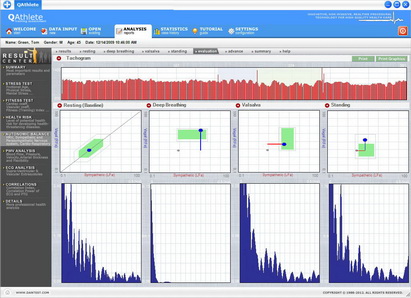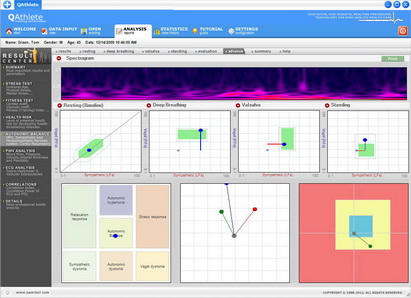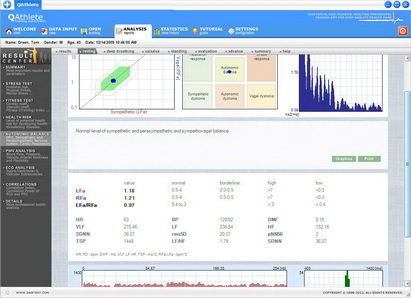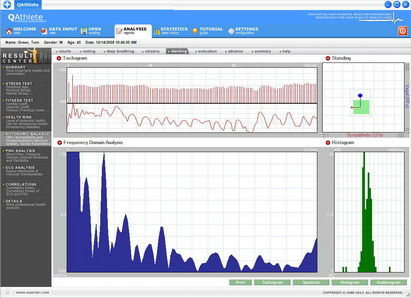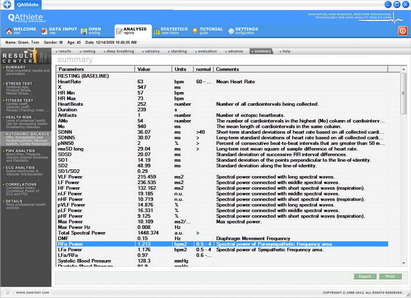Optimize Training and Recovery.
Workouts may not always have the intended effect.
Autonomic Balance Analysis - ANS
Heart Rate Variability (HRV) is a physiological function whereby the time interval between heart beats varies. These variations in heart rate reflect the quality of cardiovascular autonomic function. Autonomic function or function of the autonomic/visceral nervous system regulates involuntary action (eg. respiration, digestion) of the intestines, heart, smooth muscle, and glands. This function is divided into two physiologically and anatomically distinct, mutually antagonistic subsystems: the sympathetic nervous system and the parasympathetic nervous system.
QAthlete systems provide HRV testing which enable physicians to monitor the activity of both the sympathetic and parasympathetic branches of the autonomic nervous system (ANS) in order to accurately assess the state of a patient's autonomic function.
QAthlete provides a two-pronged approach to patient evaluation. Firstly, QAthlete is able to detect specific types of autonomic dysfunction which can consequently be linked to a multitude of clinical diagnoses. Secondly, QAthlete can be utilized for thorough, comprehensive assessments and physiological monitoring which provide physicians with a detailed and thorough patient appraisal which can often be overlooked in standard evaluations.
The wide range of clinical applications for QAthlete makes it principally different from all other classes of diagnostic devices. QAthlete allows the physician to thoroughly investigate modalities:
* Assessment of resting autonomic balance
* Assessment of reaction of the ANS on orthostatic intervention
* Assessment of autonomic reaction during Valsalva maneuver and deep breathing
* Sympathetic and Parasympathetic autonomic balance correction
The significance of the QAthlete method in the development of HRV assessment:
In the past, autonomic function could only be approximately assessed by the following three parameters: Autonomic Balance (Vegetative Homeostasis), Sympathetic Prevalence, Parasympathetic Prevalence. The criteria used for evaluating these parameters were clinical and laboratory findings therefore assessment of the autonomic function was labor intensive and not always feasible.
The introduction of HRV analysis revolutionized ANS assessment and opened new doors for its theoretical application. Making practical use of this important scientific discovery, however, required deriving a quantitative relationship between SNS and PSNS from the spectral function.
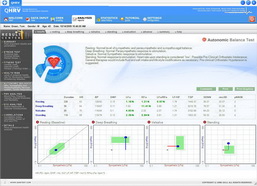
HRV analysis is based upon measuring variability in heart rate; specifically, variability in intervals between R waves - "RR intervals". These RR intervals are then analyzed by spectral (as in QAthlete) or some other form of mathematical analysis. Such mathematical analysis generates multiple parameters; time domain and frequency domain. The problem of SNS-PSNS quantification is in reducing all possible variations of these multiple parameters to a quantitative relationship between the SNS and PSNS. For many years, this issue has been the central obstacle in HRV analysis.
QAthlete is the first and only system to solve the problem of SNS-PSNS quantification. This technological breakthrough is achieved by using proprietary algorithms and a pioneering approach. The algorithms used by QAthlete have been developed and tested exhaustively for over 30 years. Studies of efficacy and accuracy have involved over 50,000 patients to ensure success.
The result of this in depth research is objective and reliable evaluations of ANS state during rest, during Orthostatic (seated-to-standing) testing and during the Valsalva maneuver combined with deep breathing. QAthlete analyses are far-reaching and highly sophisticated. Consequently, QAthlete is the only method that enables precise recognition and classification of up to 100 ANS states while providing corresponding descriptions of each.
Until the development of the QAthlete method, there was no practical means of assessing ANS independently outside of a research laboratory. QAthlete brought laboratory analyses into the physician's office and became the first and only system to provide a quantitative interpretation of HRV spectral function as well as a qualitative analysis of the resulting parameters.
The goal and achievement of the QAthlete research team is in providing physicians worldwide with a reliable office device capable of multiple clinical applications including the assessment of risk in cardiovascular diseases, objective assessment of benefit for cardiac and orthopedic intervention, and the quantification of drug effect on the autonomic function.

Significance
Heart Rate Variability (HRV) is a measure of the variation in beat-to-beat intervals in heart rate. Heart rate variability analysis is a powerful tool in assessment of the autonomic function. It is accurate and reliable, yet simple to measure (i.e. noninvasive) and quick to process.
HRV analysis measures neuro-cardiac function which reflects heart-brain interactions and autonomic nervous system dynamics. The autonomic nervous system is involved in the function of virtually every organ system and clinical manifestations of autonomic dysfunction are involved in just about every disease. As a result, HRV analysis is used as a screening and monitoring tool in many disease processes.
Applications
Higher variations in the heart rate lead to greater heart rate variability which indicates good health and well-balanced autonomic function (sympathetic and parasympathetic nervous systems). In contrast, steadier heart rate leads to lower heart rate variability which indicates an imbalance in the autonomic function and implies the presence of physiological malfunction.
QAthlete delivers laboratory analyses to the physician's office, enabling professionals to assess patient health conveniently and reliably. Applications include:
* Verifying the effectiveness of treatment and intervention
* Monitoring overall patient health
* Screening the general population
* Identifying various health issues such as heart palpitations, pain management, sleep apnea, anxiety, stress, psychological disorders, asthma, and neurological conditions
* Examining for CAN (Cardiac Autonomic Neuropathy) and DAN (Diabetes Autonomic Neuropathy)
* Measuring the Sympathetic Nervous System's predominance in cases such as Metabolic Syndrome, Hypertension or Heart Failure
* Screening for unfavorable in the absence of clinically apparent health situations
Scientific Evidence
Reduction in HRV leads to adverse prognostic implications in cardiovascular, neurological and other metabolic conditions such as diabetes and obesity.
Short term HRV analysis can identify patients at high risk for premature death within cardiac risk stratification.
HRV test procedures provide supplemental monitoring and optimized detection of early signs of adverse effects of any medications.
In general population studies, a deterioration of HRV patterns can be a useful indicator of endangered health situation related to adverse events.
Physical and pharmaceutical interventions to increase HRV lead to better individual prognosis.
Significant Clinical Applications
QAthlete assessments provide supplemental monitoring and optimized detection of cardiovascular, neurological and metabolic conditions associated with a multitude of adverse health events. The QAthlete product range provide physicians and health professionals with convenient, cost-effective solutions for clinical testing and optimized patient assessment. Applications include the following:
|
* Beta-Blocker Responsiveness * Cardiovascular Autonomic Neuropathy (CAN) * Diabetic Autonomic Neuropathy (DAN) * Cardiomyopathies * Cardiac Arrhythmias * Congestive Heart Failure * Syncope * Hypertension * Sleep Apnea * Asthma * Sudden Death |
* COPD * Peripheral Vascular Diseases * Ortostatic Hypotension * Circulation Problems * Pain Management * Neurological Conditions * Chronic Regional Pain Syndrome * Anxiety/Stress * Parkinson's Disease * Psychological Conditions * Other Hidden Diseases |

